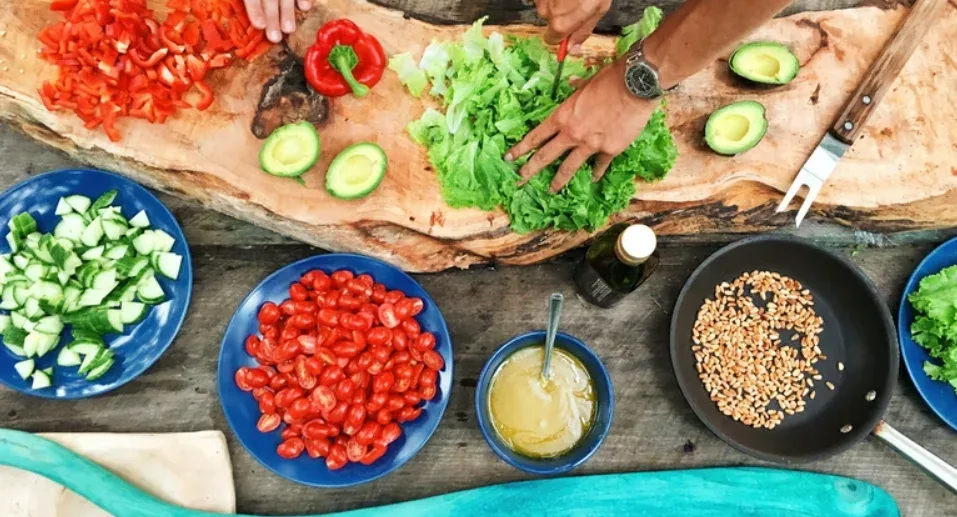You should eat snacks that contain fast-realizing carbs during a triathlon race. You must test out your snacking strategy during training. Instead, save than sorry! Nothing’s worse than standing in a toilet line during a race.
So, let’s cut right to it! My three favorite snacks are:
- Energy gels on the bike and during the run.
- Candies, on the bike.
- Energy bars (flapjacks) on the bike.
- Banana, on the bike.
Drinking and eating during a triathlon race
For a Triathlon race lasting more than 3 hours, there is a clear link between increased intake of carbohydrates and increased performance.
Research suggests that your carbohydrate goals during racing should be within the 60-90g range per hour. You can use our triathlon carbohydrate calculation to get the precise amount.
Suppose the goal is greater than 60g/hour. If the carbohydrate goal is greater than 60g/hour, the carbs must come from different sources. This will ensure maximum absorption and the least chance of stomach upset.
You should play with the amount of carbohydrates you snack on during training. Eat more than you should and see how your body reacts. This can help in helping the gut adapt to absorb carbs in high amounts and decrease the chance of having a stomach problem.

What to eat before a triathlon swim
Small servings of sports drinks or a sports gel 10-15 minutes before the start of the swim will aid in fueling the swimming.
Snacks during the bike segment
The biking section of a triathlon is the time to fuel up for the later stages of your race. Because your stomach can digest more while you’re paddling. Therefore you can consume more dense snacks such as energy bars. During the bike, you also want to make sure to fuel up your body with energy drinks for the run to come.
When I did the Ironman, I ate an energy bar every 2 hours and an energy gel every hour. During the whole segment, i sipped on the energy drinks provided on the course.
Snacks during the run
During your triathlon run segment, your stomach will have difficulty digesting energy bars. Both because your body is tired and because you’re moving around a lot.
During the run, I typically snack on energy gels. One every hour.
Carbohydrate loading before a triathlon race
Effective carbohydrate loading is done just a few days prior and with a much lower workload during training.
As the name suggests, the carbohydrate loading period should not be achieved by simply eating more food but instead a targeted intake of liquids or foods that are rich in carbohydrates.
Consultation with a certified sports nutritionist during the competition or making a proper triathlete diet plan will lessen the chance of an upset stomach and increase the amount of muscle glycogen stored.
What to eat the morning before a triathlon race
Long-distance triathlons usually begin in the morning. Generally, between 6-8 am. Ideally, a light carbohydrate-rich meal should be digested 2 hours before the race. Do not try anything new; just go with your regular breakfast choice! Eating more than usual on race morning will only cause your stomach to upset. The nutrition on the course is more than enough to get you by!
If I were to suggest a breakfast before a race, I would go with porridge or toast. For athletes with sensitive stomachs, I suggest an all-liquid meal such as smoothies with fruit or liquid meals that are food substitutes.

Hydration needs
Fluid requirements differ between individuals based on their sweat volume and composition: weather conditions and the ability to handle fluid during competing and training.
The clever triathlete should begin races hydrated and maintain the optimal amount of fluid consumed throughout the course. I suggest sipping on your water bottle or your energy drink every 15-20 minutes.
Post triathlon race recovery
Triathlon snacks and meals for recovery should include:
- Carbohydrates (fuel).
- A protein (for the repair of muscles and growth).
- A wide range of electrolytes and fluids replenish sweat loss.
A meal of recovery or snack is recommended to consume a meal or snack within a short time after completing a race or exercise. Because of the duration of the race and the intense effort, it is common for athletes not to have the desire to eat shortly after they have finished. Furthermore, they often experience an absence of craving for sweets after eating many sweets for a long time without any healthy or solid food.
Since there is typically a prolonged rest and recovery period after a long-distance triathlon. The recovery process is crucial, but it should not be taken lightly. The half Ironman distance races usually have an area for recovery near the finish line. It typically includes fruit, yogurt, ice cream, and certain sports food items. Ironman distance races may also include these, but typically warmer, more flavorful alternatives.
Small triathlon snacks are easier to digest when you reach the finish line. It is then followed by a bigger selection that is rich in protein. Some options are:
- Hot breakfast eggs beans, avo, and eggs on toast
- Finger food dishes include fats and salts like good-quality pizza, burritos, and hamburgers.
- Wraps or rolls filled with cheese, meat, and salad
- Fruit smoothies or milkshakes
- Fruit with yogurt and Granola
- Liquid meal replacements
Diet for long course triathletes
The long-course triathlete diet varies from athlete to athlete. Typically it’s tailored according to the training requirements for the day or week or even the training phase.
Since many triathletes train over five times per week, usually more than once daily, eating habits should be prioritized to help heal energy levels and maximize training adaptions.
The off-season is the best moment to concentrate on the best body composition and fitness for the coming race season and with the assistance of a sports dietitian who is certified for personalized advice. In the off-season, the triathlete diet can be altered to decrease the reliance on sports food. The number of carbohydrates consumed can be reduced to accommodate the reduced training intensity. Protein needs to be the top priority to meet your daily requirements to maintain lean mass and maximize muscle recovery following training. An ongoing intake of nutritious fats and a wide variety of vegetables, fruits, and protein-rich meat can help maintain a healthy immune system during the winter months and help with adaptations to training.
The triathlete diet should be adjusted during competition to accommodate the increased intensity of training and the necessity for high-quality training accompanied by increased performance and speed. The amount of carbohydrate consumed must be adequate to meet the daily demands for fuel but adjusted to fit the training demands for the day. Protein intake should be a priority during training sessions to aid in the optimal regeneration of muscles and immune function and recovery.
You should include a wide range of vegetables and fruits. They are essential to ensure that adequate antioxidants, vitamins, and minerals are met. Foods rich in healthy fats can also boost recovery and meet energy needs.

4 Nutrition’s Tips
- Keep a food journal for a minimum of 35 days every year to get an honest assessment of your nutrition. The log of your eating habits could help you identify your missing or overdoing areas.
- Carbs are king! Don’t be afraid to snack on carbs before, during, and after training or a race. It will only do you good.
- Don’t forget to include your vegetables and fruits! While we’ve heard this advice repeatedly, sometimes you are busy and produce the first item to go off your triathlete diet. Consume 23 fruits and 45 vegetables each day to boost your weight and intake of nutrients.
- Beware of foods high in fat or fiber in both your dinner prior to the race as well as breakfast in the morning to ensure your stomach is happy throughout the race.
What is a triathlon excatly?
Triathlon comprises three disciplines: cycling, swimming, and running into one race. Triathlon is a sport where professional athletes compete with age-group competitors of all fitness levels. The kind of training done by triathletes in preparation for a race depends on the training experience, their training schedule, and the duration of the race.
Since it is a multi-modal sport, the amount of training can be excessive due to having to incorporate training for three sports in the time span of one week’s schedule, with numerous days that consist of just two or three sessions. This means that the amount of training weekly for athletes with long-course training can vary from 10hrs for specific age groups of athletes up to 30+ hours for top athletes.
Training sessions usually include the week’s speed/interval or threshold portion. Brick sessions include more than two legs of triathlon, for example. G. A cycling session, followed by running.
The off-season of triathletes generally occurs in winter. Individual athletes may choose to stay off for a longer period of time or utilize this time to create an exercise base to help their aerobic capacity when the race season is approaching. There is usually an extended active recovery phase following a long-course triathlon.
